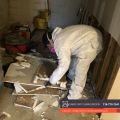Moisture Control Strategies for Commercial and Residential Properties in Coastal Areas

Properties in coastal areas like the Bay Area face unique challenges when it comes to moisture control. High humidity, frequent fog, and salt-laden air can create conditions that promote mold growth, wood rot, and structural damage. For both residential and commercial buildings, managing moisture is not just about comfort—it’s essential for health, safety, and property longevity. By implementing proactive strategies and seeking professional mold inspection, property owners can effectively minimize the risks associated with excess moisture.
Understanding the Impact of Moisture in Coastal Properties
Coastal environments naturally have higher levels of humidity due to proximity to the ocean. In such areas, moisture can infiltrate buildings through leaks, condensation, or poor ventilation. Uncontrolled moisture provides an ideal environment for mold growth, which can compromise indoor air quality and trigger respiratory issues, allergies, and other health problems. Additionally, water can damage building materials, leading to costly repairs.
For commercial properties, moisture can affect productivity, damage inventory, and create safety hazards. Residential properties face similar concerns, with mold potentially impacting the health of family members and decreasing property value.
Common Moisture Problems in Coastal Buildings
1. High Humidity Levels: Coastal air often contains high moisture content, which can condense on windows, walls, and ceilings.
2. Roof and Plumbing Leaks: Rainstorms or aging plumbing systems can allow water to penetrate structures.
3. Poor Ventilation: Inadequate airflow traps moisture indoors, especially in kitchens, bathrooms, and laundry areas.
4. Flooding and Storm Surges: Coastal properties are at risk of water intrusion during storms or unusually high tides.
5. Salt Air Exposure: Salt-laden air can corrode building materials, making surfaces more susceptible to water damage.
Effective Moisture Control Strategies
1. Improve Ventilation
Proper airflow is one of the most effective ways to reduce indoor humidity. Install exhaust fans in kitchens and bathrooms, ensure vents are clear, and consider using energy recovery ventilators (ERVs) for commercial spaces. Regularly maintaining HVAC systems also helps control indoor moisture levels.
2. Dehumidification
For both residential and commercial properties, dehumidifiers can be crucial in coastal climates. Maintaining indoor humidity between 30–50% reduces the likelihood of mold growth. In larger commercial buildings, whole-building dehumidification systems may be necessary to manage moisture consistently.
3. Regular Roof and Plumbing Inspection
Leaks are a common source of moisture problems. Regularly inspect roofs, gutters, downspouts, and plumbing to catch leaks early. Promptly repairing these issues prevents water from seeping into walls, ceilings, and floors.
4. Use Moisture-Resistant Building Materials
When constructing or renovating, select materials that are resistant to moisture, such as treated wood, cement-based boards, and mold-resistant drywall. These materials are less prone to damage and help maintain healthier indoor environments.
5. Install Proper Drainage Systems
Ensure that water drains away from the building foundation. Proper landscaping, grading, and the use of French drains or sump pumps in basements can reduce the risk of water pooling and infiltration.
6. Monitor Indoor Humidity
Invest in humidity sensors and smart home monitoring systems to track moisture levels in real-time. This allows property owners to address potential problems before they escalate.
The Role of Professional Mold Inspection and Testing
Even with the best moisture control practices, hidden mold growth can occur in coastal properties. That’s why professional mold inspection and mold testing are essential. Rick Bruce, a certified mold inspector with Bay Area Mold Pros, provides thorough inspections to identify both visible and concealed mold. Using advanced testing techniques, he can determine the type and concentration of mold spores, helping property owners take targeted remedial action.
Regular inspections not only prevent costly damage but also safeguard the health of occupants and maintain the integrity of the property.
Request a Professional Inspection
Managing moisture in coastal properties requires a combination of preventive strategies and professional guidance. If you suspect mold or want to ensure your property remains safe from moisture-related damage, contact Rick Bruce at Bay Area Mold Pros. With certified expertise in mold inspection and mold testing, Rick Bruce provides reliable assessments and recommendations tailored to both residential and commercial buildings.
Request an inspection today at (650) 762-6228 or visit Bay Area Mold Pros





